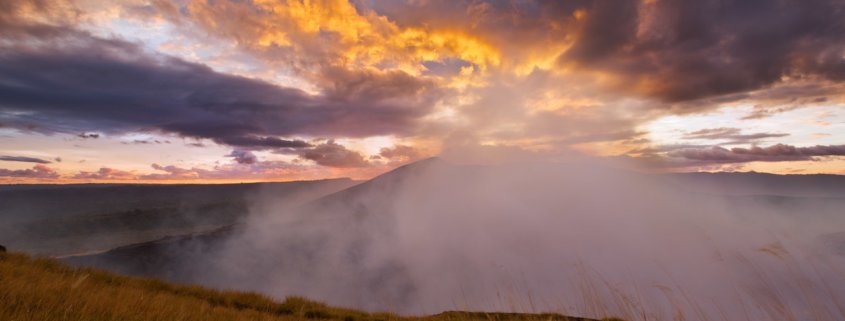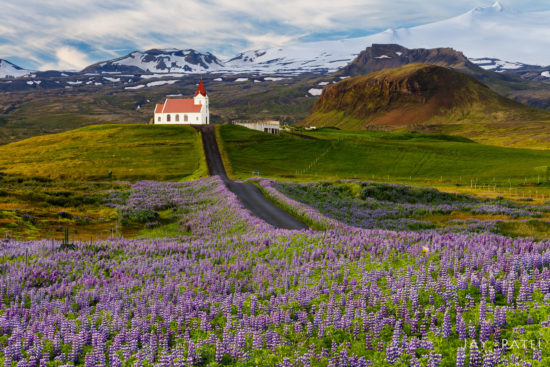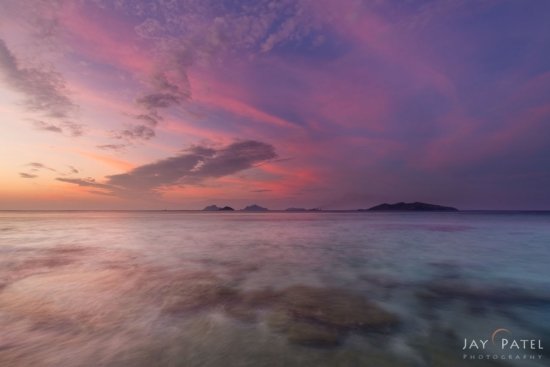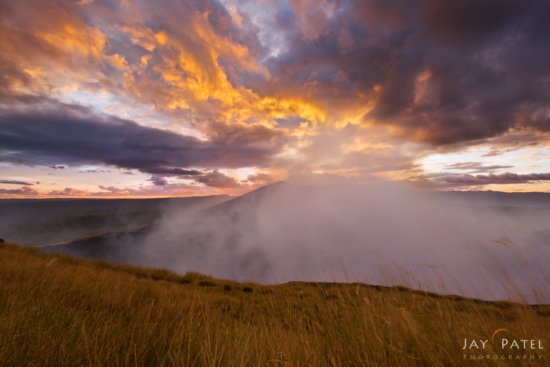Photographing During the Golden Hours
We landscape photographers love shooting during the golden hours. And why not? Just look at any dramatic photo of a landscape lit up by awesome, colorful light in those magical moments right after sunrise and before sunset. Catching a dramatic sky during the golden hours of sunset over the mountains…that’s what we live for!
The obvious trouble with shooting while the sun is on the move is that the light varies a lot- which makes getting the correct exposure really challenging. You have a few different options depending on where exactly the sun is in the sky. I’m going to give you three strategies for three different scenarios you may face when shooting during the golden hours.
Shooting Away from the Sun
We’ll talk about the easiest option first. Let’s say the sun is just starting to set and hasn’t quite dipped below the horizon. Even if you don’t have a spectacular sunset, the golden rays of light cast a nice, even lighting over the landscape. That’s just what was happening in this image I shot in Iceland:
The sun was behind me, shining over my left shoulder, low on the horizon. Its golden rays were illuminating the clouds, the flowers and the church with perfect, even light.
In situations like this one, where you’re looking away from the sun, getting the exposure right in the camera is a snap. You can use any type of metering system or take a quick look at your histogram to make sure you’ve got a good exposure. Then, just point and shoot.
Shooting Perpendicular to the Sun
The second situation is a little more complicated. This is when you’re pointing your camera 90 degrees from where the sun is setting. Here’s one such shot I took in Fiji:
The cloud formation was spectacularly lit up with colorful light, which created gorgeous reflections on the water. In a situation like this one, when the sun is to your side, you have a couple of options. If the sun is still above the horizon, part of the image will likely be blown out. If that happens, you’re going to have to manage the overexposed area by using a graduated neutral density (GND) filter, bracketing or, most likely, both. Now, if the sun is below the horizon, you may be able to maintain a pretty even exposure across the image. In that case, you can come away with a really good shot in camera.
When I took this shot in Fiji, the sun was already below the horizon. However, since the left side of the image was still pretty bright, I bracketed to make sure I was able to capture all the beautiful colors in sky and on the water.
Whether or not you’ll need to bracket depends on how wide your camera lens is. As a general rule of thumb, the wider the lens, the more over or underexposure you’re going to get across the image. If it works with your composition, you may be able to get away with just zooming in a little bit to cut out the overexposed or underexposed areas. The best thing to do is to look at your histogram and see if zooming in will do the trick. If not, you’ll have to bracket.
Shooting Into the Sun
Here’s a shot I took in Nicaragua, where the sun was going down right behind a volcano. The volcanic mist was backlit, so you could see it rising into the air, and the clouds were lit up with golden light. Pretty breathtaking! But because I was shooting straight into the sun, it was challenging to balance my exposure.
Since the lighting conditions were so extreme (the sun was still above the horizon, and I had a pretty dark foreground), I had to use a GND filter and bracket at the same time to accommodate the wide range of light. If the sun had already been below the horizon, I might have been able to get away with just using one or the other.
So the bottom line is, when you are shooting directly into the sun, you will almost always have to bracket, use a GND filter or both. The only exception to that rule is if you want to capture silhouettes and you don’t really care about foreground details. And, of course, there are times when you simply can’t use a GND filter. For instance, if the volcanic mountain had been rising over the horizon in my image, the filter would have cut the volcano in half, creating an unnatural line.
Conclusion
Shooting during the golden hours just takes a little knowledge of how to work with the varying light. If you’re just starting out and want to get great sunset shots:
- First, turn around and see what’s happening away from then sun. You’ll get a nice, even exposure and beautiful colors without needing to worry about using any special equipment.
- Next, experiment with looking perpendicular to the sun. If the sun is already below the horizon, it will be easier to get an even exposure. Otherwise, you can try zooming in to crop out the overexposed areas.
- Finally, once you have the skill set to bracket, you can shoot straight into the sun. If the light is really extreme, you’ll probably have to bracket and use a GND filter at the same time.
So that’s it! Get out there and make the most of the golden hours. And if you have any tips or questions about creating your own sunset masterpieces, be sure to let us know in the comments below!






